Archaeological excavations carried out during the summer of 2020 brought to light on the site of the former Augustodunum – today Autun, in Saône-et-Loire – a lot of exceptional objects which could have belonged to the first Christians of Gaul. Among them, an extremely rare glass vase.
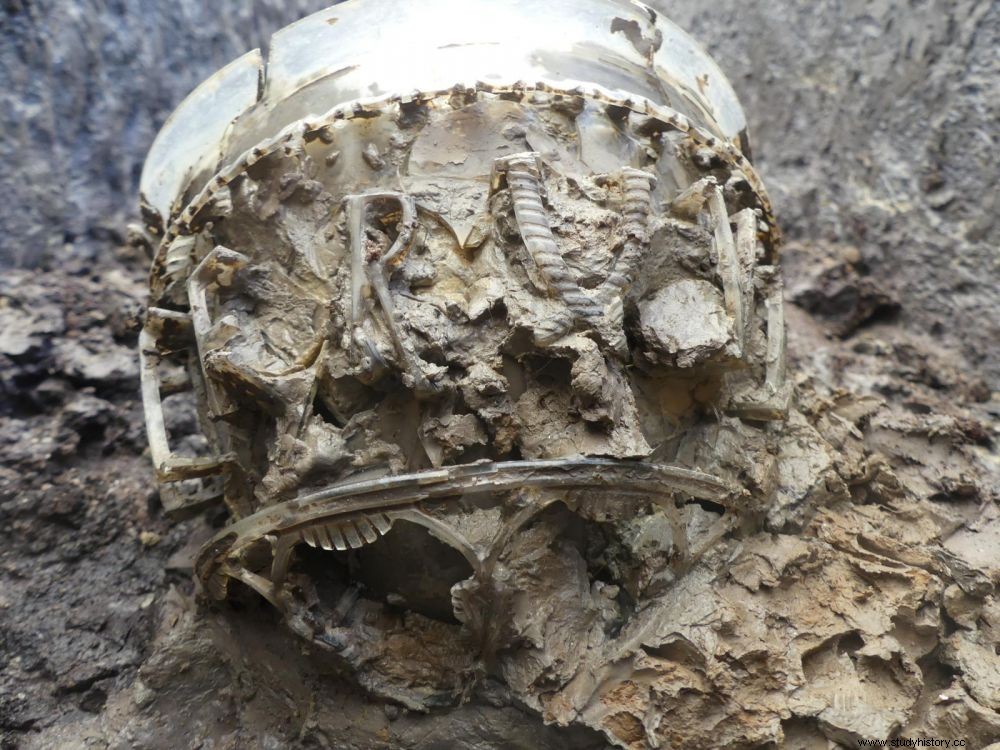
A close view of the diatrete vase, in sculpted glass, in the sarcophagus.
Dominic Lauds is known as the very first Christian poem from Roman Gaul. Written by a notable from Autun, it recounts a miracle that would have taken place in a cemetery. Did we just get our hands on this famous legendary place? Maybe. From June to September 2020, a team from the National Institute for Preventive Archaeological Research (Inrap) carried out an excavation campaign on a private plot of 1,350 m2, in Autun, in Saône-et-Loire. This plot of land covered a necropolis used between the middle of the 3rd century and the middle of the 5th century, a period corresponding to the very end of Antiquity. It is near the early Christian church of Saint-Pierre-l'Estrier, one of the oldest in Europe.
Richly adorned deceased
No less than 231 burials have been unearthed there, constituting a relatively heterogeneous set that never ceases to intrigue archaeologists. Among many wooden coffins, of which sometimes only the nails remain, lead sarcophagi have been discovered, often crushed under the weight of the earth, but also others made of sandstone. One tomb had the particularity of combining a lead coffin and a sandstone coffin, the first being embedded in the second. Enough to give researchers hope to get their hands on a body and furniture in an excellent state of preservation. Unfortunately, after opening the inner coffin, they will find that the bones were bathed in mud.
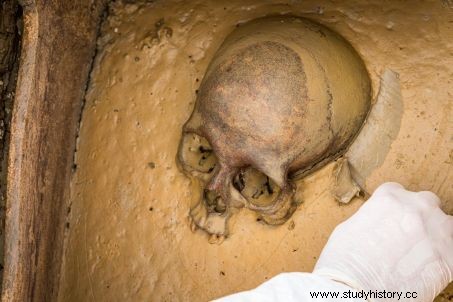
Excavation of the skull from the skeleton discovered in the lead coffin. Credits:Christophe Fouquin/Inrap
This excavation is none the less one of the most thrilling of recent years for lovers of Late Antiquity. Because although it is currently impossible to speak in their entirety of the remains of the bodies which rested in the graves, the experts assure that they were notables of the city of Autun. Witness the rare and precious objects found in certain tombs, a clear sign of belonging to high society:residues of gold threads evoking the rich fabrics of proto-Christian iconography, such as that of the mosaics of San Vitale in Ravenna where the figures surrounding the Empress Theodora wear garments sewn with gold thread; jet bracelets and gold earrings, found in a child's grave; a small ring adorned with a garnet or a very surprising set of "extremely pure" amber pins , which is "without comparison in the Roman world" , assures Nicolas Tisserand, archaeologist at Inrap and deputy head of the operation.
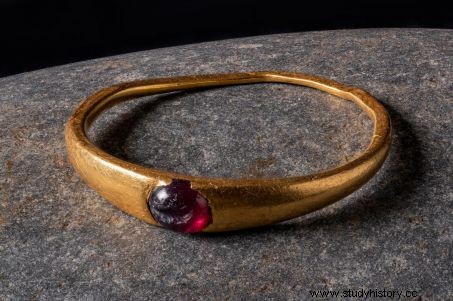
A gold ring with a garnet found in the burial of a child or adolescent. Credits:Denis Gliskman/Inrap
A masterpiece of glassware
Dominic Lauds is known as the very first Christian poem from Roman Gaul. Written by a notable from Autun, it recounts a miracle that would have taken place in a cemetery. Did we just get our hands on this famous legendary place? Maybe. From June to September 2020, a team from the National Institute for Preventive Archaeological Research (Inrap) carried out an excavation campaign on a private plot of 1,350 m2, in Autun, in Saône-et-Loire. This plot of land covered a necropolis used between the middle of the 3rd century and the middle of the 5th century, a period corresponding to the very end of Antiquity. It is near the early Christian church of Saint-Pierre-l'Estrier, one of the oldest in Europe.
Richly adorned deceased
No less than 231 burials have been unearthed there, constituting a relatively heterogeneous set that never ceases to intrigue archaeologists. Among many wooden coffins, of which sometimes only the nails remain, lead sarcophagi have been discovered, often crushed under the weight of the earth, but also others made of sandstone. One tomb had the particularity of combining a lead coffin and a sandstone coffin, the first being embedded in the second. Enough to give researchers hope to get their hands on a body and furniture in good condition. Unfortunately, after opening the inner coffin, they will find that the bones were bathed in mud.

Excavation of the skull from the skeleton discovered in the lead coffin. Credits:Christophe Fouquin/Inrap
This excavation is none the less one of the most thrilling of recent years for lovers of Late Antiquity. Because although it is currently impossible to speak in their entirety of the remains of the bodies which rested in the graves, the experts assure that they were notables of the city of Autun. Witness the rare and precious objects found in certain tombs, a clear sign of belonging to high society:residues of gold threads evoking the rich fabrics of Paleo-Christian iconography, such as that of the mosaics of San Vitale in Ravenna where the figures surrounding the Empress Theodora wear garments sewn with gold thread; jet bracelets and gold earrings, found in a child's grave; a small ring adorned with a garnet or a very surprising set of "extremely pure" amber pins , which is "without comparison in the Roman world" , assures Nicolas Tisserand, archaeologist at Inrap and deputy head of the operation.

A gold ring with a garnet found in the burial of a child or adolescent. Credits:Denis Gliskman/Inrap
A masterpiece of glassware
Finally, and above all, there is this incredible "diatrete" vase, also called "caged glass". Considered as the culmination of Roman achievements in the glass technique, this name designates an ornate glass vase set in a sort of cage. The genius of this type of object is that this lace-like glass cage is carved into the shard of glass itself. Of examples like this, there are only about fifteen discovered in the world (the last intact was discovered in Taranes, North Macedonia, in the 1970s). The work of the tomb number 16 of Autun is, him, "the first ever found in Gaul" , explained Michel Kasprzyk, an archaeologist specializing in Late Antiquity present at the excavation. 12 cm high for a diameter of 16 cm, it is decorated with sculpted decorative motifs, enhanced with letters in relief forming the words "Vivas feliciter " ("Live in bliss"). If it requires a major restoration, it wants to be complete.
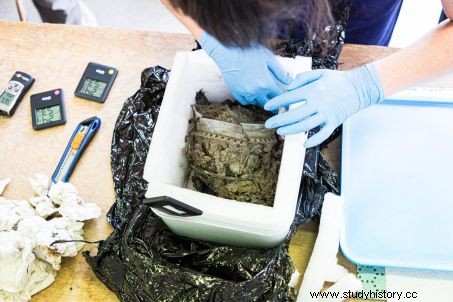
Opening of the packaging of the diatrete vase for its acclimatization. This procedure aims to prepare the object and maintain a good level of humidity, in order to protect
the object against any deterioration. Credits:Christophe Fouquin/Inrap
"All of this illustrates things that we have known for a long time:the aristocracy of Autun in early Late Antiquity was important, rich, but was only known from the texts. We knew that it maintained very important links with the emperors of the time. Several Autunois were also known in the imperial administration of Constance and Constantine" , reports Michel Kasprzyk.
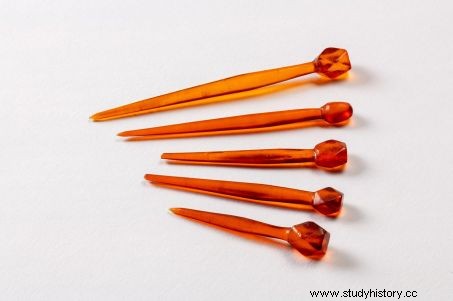
Amber pins found at the foot of the individual buried in sarcophagus 43. This is an exceptional set that knows little or no comparison in the Roman world. Credits:Denis Gliskman/Inrap
If the exhumed remains do not directly confirm the religious affiliation of the deceased, the archaeologists are nevertheless convinced that this necropolis must have accommodated the burials of the first Christian community of Autun, and therefore among the very first Christians of Gaul. And for good reason:the famous stele of Pektorios, one of the oldest documents of Christianity in Gaul, was discovered near this necropolis in the 19th century.
